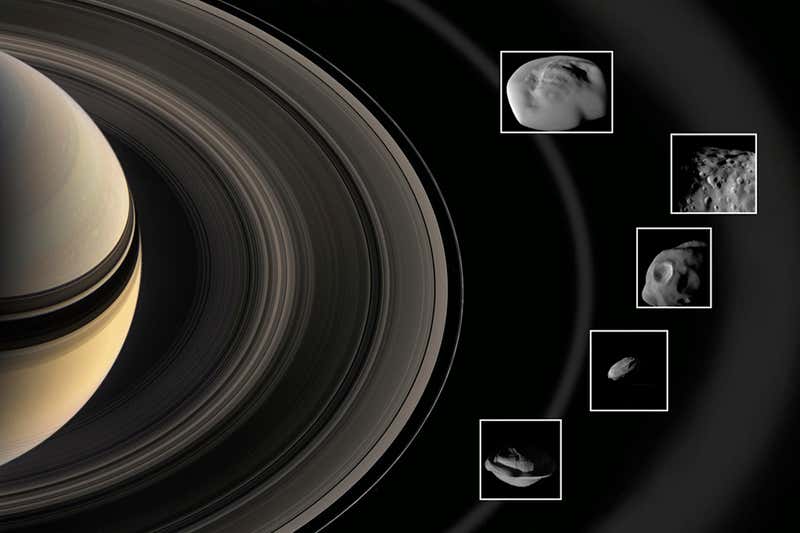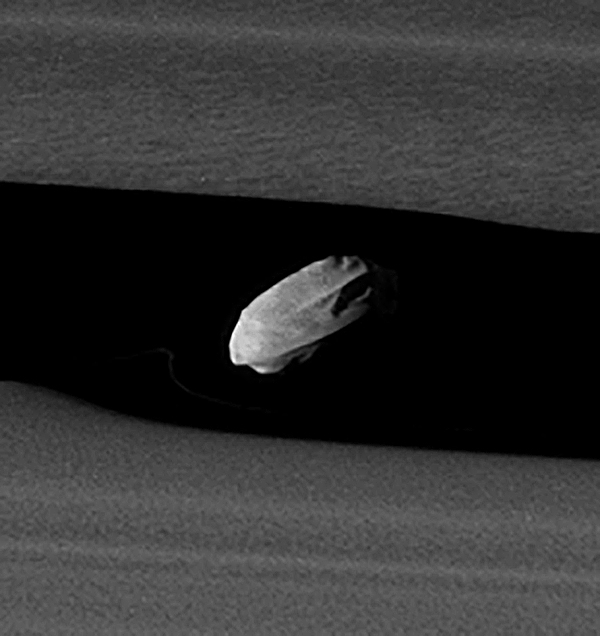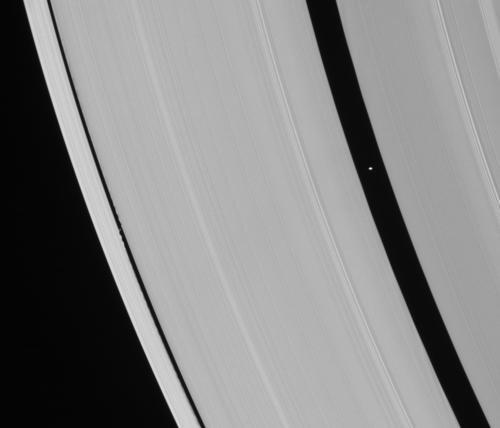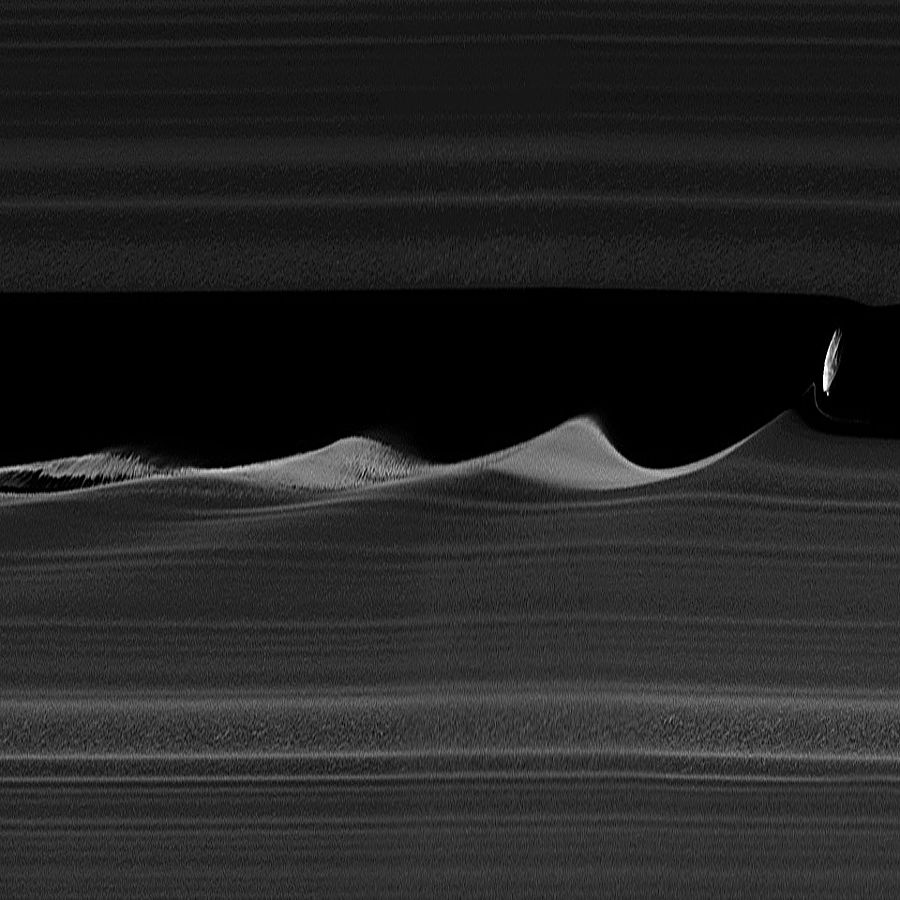What Is a Ring Shepherd Moon?
The rings of Saturn are not solid. They are made up of mostly ice and some rock particles of different shapes and sizes. These materials are suspended in space, floating and orbiting around the gas planet. The ring shepherd moons of Saturn, such as the Daphnis moon, help in keeping the form of its rings. These moons are able to do so because they orbit the planet within the rings. As they move around Saturn, they “kick” the loose materials back into the ring. In short, shepherd moons help contain ring particles by guiding them back to their places, just as shepherds tend their flocks.

Two shepherd moons maintain the Encke Gap and the Keeler gap in Saturn’s A ring. Within these gaps are Pan and Daphnis. They keep the lanes open and free of space debris as they orbit the planet, making sure that no ring particles remain off track.
Other shepherd moons are Atlas, Prometheus, and Pandora. The co-orbitals Janus and Epimetheus are also shepherds maintaining the shape of the outer A ring.

The Daphnis Moon
Daphnis Moon: Facts and Figures
All About the Name
- Pronunciation – /ˈdæfnɪs/
- Behind the name – Daphnis (Believed to have invented bucolic poetry in Greek mythology)
- Adjective – Daphnidian
- Other designation – Saturn XXXV
- Provisional designation – S/2005 S 1
Discovery Details
- Discoverer – Cassini Imaging Science Team
- Discovery date – May 1, 2005
Orbital Characteristics
- Parent Planet – Saturn
- Orbital period – 0.5940798 day/s (14.257915 hours)
- Average Orbit Distance – 136,505.5±0.1 km
- Mean Orbit Velocity – 60,161.0 km/h
- Orbit Eccentricity – 0.0000331±0.0000062
- Equatorial Inclination – 0.0036°±0.0013°
Physical Features
- Dimensions – 8.6 × 8.2 × 6.4 km
- Equatorial radius – 3.8±0.8 km
- Equatorial circumference – 23.9 km
- Volume – 230 km3
- Mass – (7.7±1.5)×1013 kg
- Surface area – 181.46km2
- Mean density – 0.34±0.26 g/cm³
- Surface gravity – 0.0001–0.0004 m/s
- Rotation – Synchronous (tidally locked)
- Axial tilt – Unknown
- Albedo – Approximately 0.5
- Temperature – Approximately 78 K
Daphnis Moon Features
Daphnis is one of Saturn’s shepherd moons. It is also designated Saturn XXXV. It was discovered on May 1, 2005, by the Cassini Imaging Science Team. Before it was assigned a formal name, this little moon was designated S/2005 S 1.

With a diameter of about 8 kilometers, Daphnis is smaller than Earth by about 1676.6 times. It does not have a spherical appearance unlike the larger satellites of Saturn. Instead, it appears irregular, something common among moons orbiting within or close to the planet’s rings.
Many describe Daphnis as a “wavemaker.” That is because it creates waves as it orbits Saturn in the Keeler Gap. This gap lies within the bright A ring of Saturn. Daphnis inhabits the A ring together with the other moonlet, Pan. And while Daphnis is in the Keeler Gap, Pan is in the wider and inner Encke gap. We can call these two “embedded moons” because they orbit Saturn inside the A ring.
The name “Daphnis” is from the rich collection of characters and stories of Greek mythology. The young man Daphnis was a shepherd. He was related to Pan, the god of shepherds and flocks. Equally, the same name was the inspiration of another one of Saturn’s ring shepherd moon, Pan.
Daphnis’ Orbit
It takes about 14 hours for Daphnis to orbit around Saturn. Though it is inclined at only 0.0036°, it is still greater than Pan’s next to zero inclination of 0.0001°. Daphnis‘s inclination is responsible for its 17-km upwards and downwards movement.
Daphnis orbits Saturn at a distance of about 136,500 km. Its orbit is not particularly eccentric. However, it is enough to vary the distance of this tiny moon to its parent planet by about 9 km. It has an eccentricity of roughly 0.0000331. Still, this is greater than its A-ring neighbor Pan which is 0.0000144.
Daphnis has a mean radius of 3.8 km or 2.4 miles. Its complete dimension is 8.6 × 8.2 × 6.4 km. The mass of this tiny moon is 77,930,758,521,054 kg. Its surface area is about 181 km2, roughly 200 thousand times smaller than the surface area of our planet’s Moon. It is estimated to be as hot as the walnut-shaped Pan whose temperature is around 78 K.
Daphnis is in a synchronous rotation with Saturn. This phenomenon is also called tidal locking or captured rotation. As a result, the same side of this satellite always faces the planet. It happens because Daphnis completes its orbit around Saturn at the same time that it rotates on its own axis.
The Keeler Gap

The Keeler Gap is 42 km wide, about 7 times narrower than the 325-km wide Encke Gap. It is roughly 250 km from the outer ring of A ring. The shepherd moon Daphnis clears this gap of space debris.
The image above shows the two gaps of the A ring. The bigger one on the right is the Encke Gap. The tiny bright dot inside it is the moon, Pan. On the left side is the Keeler Gap where Daphnis is.
The Keeler Gap was discovered by NASA’s Voyager. It was named after the American astronomer James Edward Keeler. He was known for his studies about the rings of Saturn using astrophotography. Although he was not the discoverer of the ring portion that was named in his honor, he was the one that discovered the Encke Gap. He named it in honor of another great astronomer, Johann Encke.
The Waves
The wave that the Keeler Gap possesses is caused by Daphnis. This football-shaped moon creates these waves as it makes its way through the gap. How so?

The gravitational pull of Daphnis perturbs the ring particles on the edge of the Keeler Gap. Other factors behind the waves have to do with Daphnis’s small orbital eccentricity and inclination.
The slightly inclined orbit of Daphnis causes it to oscillate or swing above and below the plane of Saturn’s rings. This movement affects the materials along the narrow Keller Gap.
It is also important to note that materials on the inner edge of the gap orbit a little faster than Daphnis while those on the outer edge are slower.
As Daphnis moves up and down, prominent waves are formed on the outer margins. The ring materials trail and lag behind the moon because of their slower orbital speed. Waves form ahead of Daphnis on the inner edge because icy particles orbit faster on that side.
Because of the reasons mentioned above, the rings surrounding the Keeler gap have vertical components aside from the horizontal ones. These objects can be 1,500 m higher than the plane of the ring and thus look like waves.
What Does Daphnis Look Like?

Daphnis appears irregular and elongated. A few craters were observed on its overall smooth surface. Like Pan, Daphnis has an equatorial ridge which is believed to be accredited material from the ring as it orbits around Saturn.
The best image that we have of Daphnis was taken on January 16, 2017. The Cassini spacecraft used a narrow-angle camera to make out the oddly-shaped moon and the waves that it makes in its wake. Cassini was roughly 28,000 kilometers from the moon during this flyby.
Discovery
Before the discovery, astronomers have already suspected the presence of an object in the Keeler Gap. They have detected gravitational ripples in the outer edge of this open lane.
The previous assumption was confirmed when it was seen on the images that the Cassini probe took on May 1, 2005. The discovery of this small moon was announced 5 days later, on May 6, 2005. The good news was released by the Cassini Imaging Science Team (photo shown above).
Behind the Name
As with the other satellites of the planet Saturn, the name “Daphnis” has its roots in mythology. Specifically, its moons are named after the characters surrounding the mythological Saturn of Roman mythology (Greek counterpart: Cronus). It included the names of the Titans and Titanesses and some characters related to them.

Daphnis was a well-known shepherd of Sicily in Greek mythology. He was also a pastoral poet and a pipe player. Despite being the son of Hermes and a nymph, the young man was mortal.
It was said that Daphnis was named after the laurel tree where his mother left him. It connects to the story of the Naiad-nymph Daphne who turned into a laurel tree. He grew up to be a fine and beautiful young man who preferred the pastoral life over the crowds.
Unfortunately, the Sicilian shepherd had an early death. It was a tragedy of love and revenge. A Naiad (likely named Echenais, Nomia, or Lyce depending on the writer) fell in love with the young man and made him promise to be loyal to her.
Sad to say, a princess seduced Daphnis and made him drunk, making him break his promise to the nymph. The Naiad became so angry that she blinded him as revenge.
Many stories surround the end of Daphnis. It was commonly believed that he had fallen off a cliff or was turned into a stone. A lighter version of the story claimed that his Olympian father Hermes took him to heaven to be with the gods.
Daphnis In Writing
Daphnis became a subject in some literary works. The Sicilian poet Theocritus, like other pastoral poets, sang of Daphnis in his bucolics, particularly in Idyll 1. In his version of the story, Aphrodite inflicted Daphnis a hopeless passion for a woman. The goddess brought this upon him because the young man offended her and the god Eros. Daphnis was tormented with his unrequited love, and upon his death, Aphrodite tried to save him but it was too late.
The ancient Greek novel writer Longus wrote “Daphnis and Chloe.” It tells the story of two children who were abandoned by their birth parents. Daphnis was found by a goatherd while Chloe was discovered by a shepherd. They were raised by the people who saved them. The two grew up together and developed feelings for each other. The story ended happily as they found their birth parents and married each other, after many adventures.
French composer Maurice Ravel drew inspiration from the work of Longus. He wrote a ballet with the same title, Daphnis et Chloé.
The name Daphnis was chosen for the shepherding moon because the young man was one of the many descendants of the Titans. He was also related to the god Pan who taught him how to play the pipes.
The adjectival form of the name Daphnis is “Daphnidian.” As an adjective, we use it when describing this moon or something related to it.
Statistical Sources:
- https://en.wikipedia.org/wiki/Daphnis_(moon)
- https://solarsystem.nasa.gov/moons/saturn-moons/daphnis/by-the-numbers/
Image Sources:
- Ring shepherd moons: https://www.zmescience.com/science/largest-ring-system-found-feature/
- Daphnis moon: https://en.wikipedia.org/wiki/Daphnis_(moon)
- Keeler gap (with Encke gap): https://caps.gsfc.nasa.gov/simpson/kingswood/rings/
- The waves: https://commons.wikimedia.org/wiki/File:Daphnis_makes_waves_-_4x_vertical_stretch.jpg
- Daphnis’s waves behind and ahead & what it looks like: https://astronomynow.com/2017/01/19/saturns-shepherd-moon-daphnis-makes-waves/
- Cassini imaging team: http://ciclops.org/team/iss_team.php
- Daphnis (with Pan): https://en.wikipedia.org/wiki/Daphnis